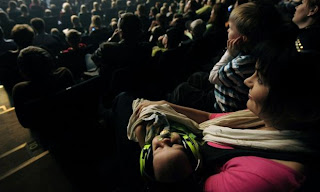Here are some of my favorite speech and language things to do with pumpkins this time of year:
1. Pumpkin Carving Sensory and Language Exploration
Whether your pumpkins trend toward the scary, the silly, or the traditional, this is a great way to get kids digging into the season with some great sensory and language play.
Sensory:
While carving the pumpkin, invite the little ones to help scoop out the guts. Getting messy is an important part of childhood, and pumpkin innards provide a ton of great input. You can squish them, pull them, stretch them...you name it, really. For some extra fine motor fun, have a little contest to see who can get the most seeds out of the pumpkin. They're great for roasting later, and who doesn't enjoy eating the fruits of their labor?
Language:
Choosing eyes, a nose shape, a mouth, and/or a picture to carve provides great opportunities for making choices and describing things. Encourage your tykes to not only say "that one," but to tell you why they like it, or what shape it is. It's okay to play dumb to get them a little more into telling you ABOUT what they choose. Trust me, it works wonders. And when you get to the actual carving, there's even more to talk about!
2. Pumpkin Patch Adventure
The pumpkin patch is a great place for language in the fall. Whether it's in a parking lot, a farm stand, or out in the country, there are lots of things to see and do.
Any pumpkin patch (or stand) worth its salt will have many different shapes and sizes to choose from. It's a great opportunity to talk adjectives with your kiddos. Do you want tall, short, fat, round, etc?
Most pumpkin patches will also have a variety of types of pumpkins, gourds, and squash to purchase. Investigate the size differences, the textures (the little bumpy ones are my favorite), and shapes (I also love the swan neck gourds). See if you can find a Cinderella or Fairytale Pumpkin and talk about why it might be named that!
3. Pumpkin Flavored Everything
Fall is the time when it seems like every major brand has a pumpkin SOMETHING. A grocery store hunt for pumpkin foods is the perfect way to discover and celebrate all these seasonal delights!
When you bring your selections home, you can cook/serve them up and talk about what makes them great, not-so-great, or downright icky (I'm looking at you Pringles Pumpkin Pie Spice). With kids (of all ages), it's so important to foster an atmosphere and attitude of adventure and comfort with trying new things, especially foods. For the especially picky or problem eaters, this is much easier said than done.
The most important thing to remember is to start where your child is, and then lead them a little further. If they are absolutely against touching pumpkin guts (I was, and I still get a little ishy), let them choose the eyes or the nose. Offer then a pumpkin seed instead of the stringy innards.
If you have a picky/problem eater, start with a food that's orange, or a favorite snack in a different shape. Make it fun and non-threatening, and never force. If it comes to a battle of wills, yo're going to lose. Every time.
Looking for some more ideas for fun fall snacks? Head on over to the Bento of the Week blog and check out their pumpkin-themed offerings.
Enjoy the brisk weather! I'll be back next week with some Halloween fun!




















